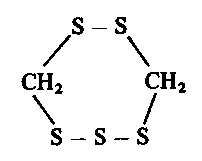Sienien hedelmälihassa esiintyvien aromiaineitten kemiallinen luonne. Kirjallisuuskatsaus aiheeseen. ( Täytyy olla oikein fungofiilin kirjoitus).
http://www.fransdijkstra.nl/diss/chapter4.htm
4. THE CHEMICAL NATURE OF THE FLAVOUR OF FRUIT BODIES OF MUSHROOMS
4. 1. Brief literature review
- Vuonna 1966 eristettiin lentinoni, LENTHINONE Lentinus edodes - hedelmälihasta. Tämä on aromia kantava aines sienissä ja alla kuvataan sen rikkipitoinen rakenne.
Lisäksi osoittautui että nukleotidi 5´-GMP oli samassa tutkimuskohteessa tärkeä arominvahvistaja-aine. Myös 5´-AMP stimuloi aminohappojen , erityisesti glutamaatin aromia, vaikka erikseen testattuna aromi oli vähäinen.
In 1966 Morita and Kobayashi [107] reported the isolation of lenthionine from fruit bodies of Lentinus edodes. It was the aroma-bearing substance of this mushroom and had the following unusual structure:

Furthermore guanosine-5'-monophosphate (5'-GMP) was shown to be an important flavour enhancing factor in Lentinus edodes. This nucleotide and, to a smaller extent, adenosine-5'-monophosphate (5'-AMP) stimulate the flavour of amino acids, especially glutamic acid, although they have little flavour when tasted alone [62,86].
(The flavour of Lentinus edodes, fruit bodies of which are grown on a large scale in Japan, differs completely from the flavour of other edible mushrooms such as Agaricus bisporus, Boletus edulis and Coprinus comatus).
- Sitten havaittiin että tärkeä aromiaine yllä mainituissa syötävissä sienissä oli 1-okten3-oli, rakenteeltaan alkoholinen molekyyli.
(An important aroma compound in the latter mushrooms is 1-octen3-ol.
This compound was first isolated from Armillaria matsutake by Murahashi [111]. Thirty years later Freytag and Ney [46], isolated it from Agaricus bisporus. In both mushrooms the alcohol was optically active (leavorotatory).
- Viime vuosina on tutkittu sienien haihtuvia yhdisteitä. Coprinus comatus lajista löydetyt on taulukoitu ( Taulukko 20)
- Mainittujen haihtuvien yhdisteiden lisäksi löydettiin syötävästä tatista Boletus edulis n 60 muuta yhdistettä, joista yhdeksän oli pyratsiineja, seitsemän oli 2-formyylipyrroleita, kuusi oli rasvahappoa ( kokoa C5- C10), viisi oli furaanijohdannaista, neljä oli laktonia ja neljä oli alifaattista ketonia.
- Moni näistä yhdisteistä muodostui kaiketi kuivaamisen aikana. Tuoreessa Boletus edulis tatissa oli havaittavissa benzaldehydiä, 3-heptanonia. isovalerihappoaldehydiä, asetaldehydiä, metyylisykloheksanonia ja neljä tunnistamatonta yhdistettä.
- Agaricus bisporuslajista löytyi vielä etyleeniä, alhaisessa lämmössä kiehutettaessa haihtuvia tuotteita ( asetylaldehydiä, asetonia, etanolia ja etyyliasetaattia) ja lyhytketjuisia rasvahappoja ( etikkahappoa, isovoihappoa, isovalerihappoa ja n-voihappoa)
- Agaricus bisporus lajista löytyi haihtumattomina osina aminohappoja, nukleotidejä ja hiilihydraattia. Boletus edulis tatista löytyi useita aminohappoja.
- Ainoina aineina , jotka vaikuttivat sienten hajuun mainitaan seuraavia: 1-octen-3-one ja 1-octen-3-ol. Karakteristinen Boletus edulis-aromi liittyy baasiseen aminohappofraktioon. Ehkä glutamaatti, lyhytketjuiset rasvahapot ja hiilihydraatit omannevat osuutta sienten aromiin.
- Eräitä sieniaromipatentteja on esiintynyt: kuten Nobukunin et. al. käyttämä 1.2.4.5.-tetratihiohexane sienen tuoksuna. Benz et Mezzino väittivät, että 2,4,5-trimethyloxazolen ja diascetyl - molekyylien seos antaa maan tai perunankaltaisen tai sienen kaltaisen tuoksun elintarvikkeeseen . Ei olla selvillä siitä, jos näitä molekyylejä on tunnistettavissa sienistä.
- Lisäksi rikkipitoinen 1,2,4,5- tetrathiohexane matkii todennäköisesti Lentinus edodes- aromia. Henriques et al. raportoivat, että haihtumattomia 1-okten-3-oni- ja cis- 4- heptenal johdannaisia voitaisiin valmistaa karbonyyliryhmän reaktiossa tiazolidiiniini- 4- karboksyylihapon kanssa. Kuiva-aines voitaisiin lisätä kuivaan sienisoppavalmisteeseen. Kuumennettaeesa rehydroitua soppaa 1-octen-3-one ja cis-4-heptenal. vapautuisivat antaen sieniaromin. soppaa tehtäessä.
...Päivitys 19.10. 2013
Inga kommentarer:
Skicka en kommentar